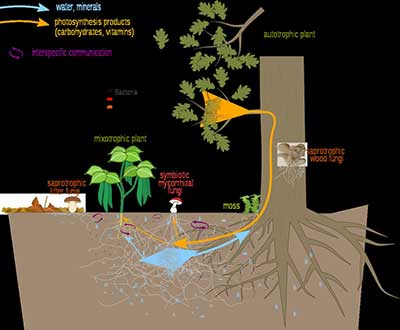Relevance: GS-3: Conservation, environmental pollution and degradation, environmental impact assessment
Key phrases: Society for the Protection of Underground Networks (SPUN),Book-The Hidden Life Of Trees, Food and Agriculture Organization, Mycorrhizal fungi, Myconauts, Coral reefs of the soil
Why in News?
- Recently, a non-profit science initiative—the Society for the Protection of Underground Networks (SPUN)—hopes to map and preserve the world’s underground fungal life by using machine learning and collaborating with researchers worldwide.
- Their ultimate goal: fighting climate change.“Protecting underground ecosystems is crucial to fighting climate change.
- The initiative focused on protecting fungal networks that are a massive carbon sink, and can make up over 50% of the living biomass of soils
Key Points regarding Fungal Networks
- German author and forester Peter Wohlleben in his 2016 book The
Hidden Life Of Trees:
- Writes about how fungal networks have an integral relationship with trees.
- Not only do they help them exchange nutrients, they help in sending warning signals if a tree is under attack from pests or other predators.
- It may not be a stretch to say that trees and fungal networks have a “friendship” of sorts.
- Unknown to us, the world beneath our feet is home to an entire ecosystem.
- According to a 2020 report from the Food and Agriculture Organization
(State Of Knowledge Of Soil Biodiversity—Status, Challenges and
Potentialities):
- Soils are home to 25% of all species on Earth.
- More importantly, though, current trends suggest that by 2050, over 90% of Earth’s soil will be degraded.
- Fungal networks could be key in averting such a crisis.
Significance of Fungal networks
- Fungal networks are the base of healthy soils. “They underpin life on earth”.
- They can help sequester carbon, move nutrients such as phosphorus and protect ecosystem biodiversity.
- Fungi create a sticky living seam that holds soil together; remove the fungi, and the ground washes away.
- Plant roots feed carbon to these fungal networks in exchange for nutrients the fungi collect from the soil. These networks form nutrient highways between plant roots and the soil. In science they are called ‘mycorrhizal fungi’.
- Organisms such as bacteria also use these fungal “highways” to travel between different roots of a plant.
- The impact of climate change is not clearly understood:
- So, there is a need to map fungal networks to understand how their distribution is going to change in response to climate change.
- Global aim shall be to find and map the ‘Amazon forests’ of the underground.
- Writing in Wohlleben’s book, Canadian scientist and forest ecologist
Suzanne Simar—describes:
- “mycorrhizal fungi” as “mutualistic”, interacting with trees in a carbon-nutrients exchange.
- In fact, billions of tons of carbon dioxide flow annually from plants to fungal networks.
- This helps make soils the second largest global carbon sink, after oceans.
Steps taken
- SPUN initiative for global mapping of Fungal networks
- Recently, researchers and local communities around the world collect around 10,000 fungal DNA samples from diverse ecosystems, with a focus on underexplored regions and those facing increasing threats from land-use change.
- The scale of this project—a complete map of Earth’s underground networks—is so massive that it requires global participation.
- SPUN team started to engage local people all over the world to collect samples and become “myconauts”—“myco” is fungus, and “naut”, explorer.
- This project can only be successful if we are able to work with communities all over the world to help us sample soils around the globe.
- But setting up an infrastructure to process samples from all over the world is a big challenge.
- The other challenge is timing. “Fungal networks are disappearing at an alarming rate. Networks are threatened by agricultural expansion, deforestation and urbanisation. To reduce this, satellite imagery of fungal networks have started.
- Once ready, this map and satellite imagery will also help scientists link different fungal communities to their functions and ecosystems in the future.
- These initiatives could also help in documenting new fungal species—for the networks stretch to quadrillions of kilometres.
- The new efforts by researchers and mathematicians
- To model changes in climate patterns and land use by predicting the distribution of fungal networks as they shift in response to climates and patterns of land use, in the same manner as they already do for global vegetation, climates and ocean currents.
Conclusion
- The work of researchers like Wohlleben and Simard—has brought to the surface many secrets about underground fungal networks; they believe there is so much more to learn about these “coral reefs of the soil”.
- Scientists started documenting the importance of fungal networks. But this work is in its nascent stage,“Underground climate science is still in its infancy. But people are finally starting to take notice of its importance.”
Source: Mint
Mains Question
Q.Fungal networks are the base of healthy soils. “They underpin life on earth, called as coral reefs of the soil”. Discuss. Also mention, how does the recent global initiative to map fungal networks across the planet will help in its conservation? (15 marks)









